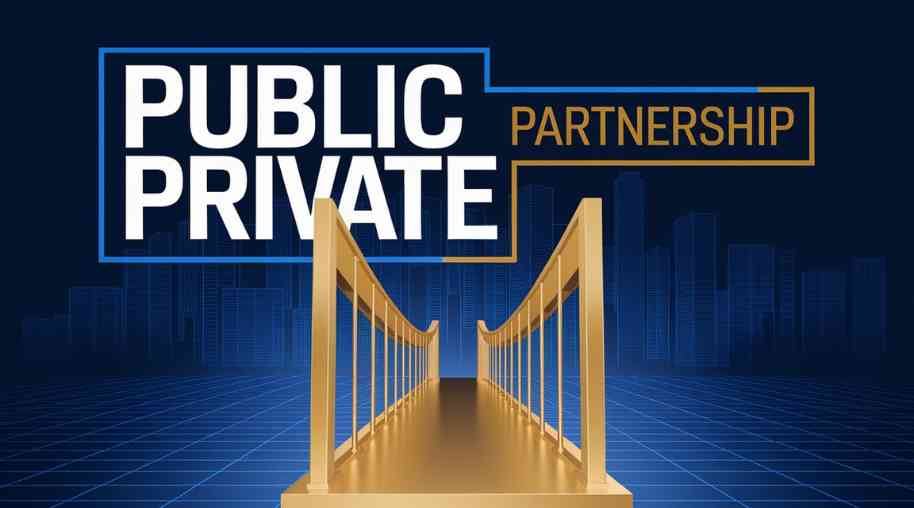PPP Full Form-Public Private Partnership
by Shashi Gaherwar
0 1012
Public-Private Partnership: A Catalyst for Economic Growth
Introduction
Public-Private Partnerships (PPP) are collaborative arrangements between government entities and private sector companies to finance, develop, and manage public infrastructure and services. This model has gained prominence worldwide as an effective way to leverage private investment, innovation, and efficiency while addressing public sector challenges.

PPP projects span various sectors, including transportation, healthcare, education, energy, and urban development. By balancing public interest with private sector expertise, PPPs facilitate infrastructure expansion, economic development, and service improvement.
Understanding Public-Private Partnership (PPP)
A Public-Private Partnership is a long-term agreement where the government collaborates with private firms to design, finance, build, operate, and maintain public infrastructure or services. This partnership allows the government to share risks with private players while ensuring quality service delivery to citizens.
Key Features of PPP:
• Risk Sharing: Both public and private entities share financial, operational, and performance-related risks.
• Long-Term Agreement: PPP contracts typically last 15-30 years, ensuring project stability.
• Performance-Based Payments: Private entities receive payments based on service quality and efficiency.
• Innovative Financing: PPPs attract investments without overburdening government finances.
Types of PPP Models
PPP arrangements vary based on project scope, financing, and operational control. Some common models include:
1. Build-Operate-Transfer (BOT)
• Private companies finance, construct, and operate a project before transferring ownership to the government after a set period.
• Used in highways, airports, and water supply projects.
2. Build-Own-Operate (BOO)
• The private entity builds, owns, and operates the project indefinitely, with minimal government involvement.
• Common in power generation and telecom sectors.
3. Design-Build-Finance-Operate (DBFO)
• The private sector takes full responsibility for designing, constructing, financing, and operating infrastructure.
• Applied in urban transit systems and toll roads.
4. Lease-Develop-Operate (LDO)
• The government leases an existing asset to a private firm, which upgrades and operates it.
• Used in railway and port modernization projects.
Benefits of Public-Private Partnerships
PPP models provide numerous advantages for governments, private entities, and the general public:
1. Infrastructure Development Without Fiscal Burden
• PPPs enable governments to execute large-scale infrastructure projects without excessive public debt.
• Private capital investment reduces dependence on taxpayer funding.
2. Improved Efficiency and Innovation
• Private firms bring expertise, advanced technology, and management efficiency.
• Faster project completion and better service quality.
3. Risk Mitigation
• Financial and operational risks are distributed between public and private entities.
• Performance-linked contracts ensure accountability.
4. Job Creation and Economic Growth
• PPP projects boost employment in construction, engineering, and service sectors.
• Improved infrastructure attracts foreign investment and supports business expansion.
Challenges and Risks in PPP Projects
While PPPs offer significant benefits, they also pose challenges that must be addressed for successful implementation.
1. Complex Contract Negotiations
• Legal and financial agreements require extensive planning and expertise.
• Disputes over risk-sharing and project scope may delay execution.
2. High Initial Investment
• Private investors require substantial capital, which may limit participation from small firms.
• Cost overruns and financial mismanagement can impact project viability.
3. Public Opposition and Political Risks
• Citizens may oppose privatization due to concerns about affordability and accessibility.
• Changes in government policies or leadership can affect PPP agreements.
4. Long-Term Commitment and Uncertain Returns
• Long concession periods (20-30 years) make PPPs a high-risk investment.
• Future economic conditions and regulatory changes may impact profitability.
Successful Examples of PPP Projects
Several countries have implemented PPPs to develop world-class infrastructure and services. Notable examples include:
1. Delhi Metro Rail (India)
• A landmark PPP project that transformed urban transportation in India.
• Involves collaboration between the Delhi Metro Rail Corporation (DMRC) and private investors.
2. London Underground (UK)
• Private firms partnered with the UK government to modernize and operate the underground railway system.
3. Sydney Motorway (Australia)
• A toll-based PPP model that expanded road infrastructure to reduce traffic congestion.
4. Healthcare PPPs in Brazil
• Public hospitals partnered with private entities to improve medical facilities and patient care.
The Future of Public-Private Partnerships
As global infrastructure needs grow, PPPs will play a crucial role in smart cities, renewable energy, and digital infrastructure. Future trends include:
1. Green and Sustainable PPPs
• Focus on renewable energy projects (solar, wind, hydro) to promote sustainability.
• Smart city developments integrating energy-efficient buildings and transportation systems.
2. Digital Infrastructure and Smart Technologies
• PPPs in broadband expansion, 5G networks, and smart transportation.
• Public-private collaboration in cybersecurity and digital governance.
3. Policy and Regulatory Enhancements
• Governments refining legal frameworks to ensure transparency and accountability.
• Standardization of PPP models for global investment attraction.
Public-Private Partnerships are a powerful tool for infrastructure development and economic growth. By leveraging private sector investment and expertise, governments can enhance public services, drive innovation, and meet growing urbanization demands. However, successful PPP implementation requires clear policies, transparent governance, and risk-sharing mechanisms.
With the right balance between public welfare and private profit, PPPs will continue to shape the future of global infrastructure, making economies more resilient and sustainable.

Share:








Comments
Waiting for your comments